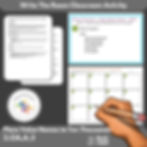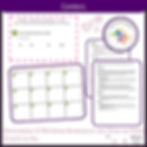Math skills based IEP goals are especially important for students with special needs. That's why it's important to set math IEP goals that target specific skills like number identification, counting, and more. Keep reading to learn more about how our effective sample math IEP goals for your students!
It's hard to know where to start when writing IEP goals for math.
There are so many state standards to cover and it can be hard to know where to start. How do you make sure that each goal is achievable and meaningful for your student?

TeachTastic has got you covered! Our free list of Math IEP goals includes objectives for all major standards from kindergarten through fifth grade. Plus, each goal is scaffolded with three skill objectives so you can hit all the important points. Just copy and paste these easy-to-use goals into your student's IEP and you're good to go!
Here are a few great samples of smart iep goals from our iep goal bank guaranteed to make any special education teacher's job a little easier. If you don't find what you are looking for click here to see our entire IEP goal bank by grade level, standard, and basic skill. Many of our top higher grade level goals are two step word problems, geometric measurement, and double digit numbers to name a few. Whatever you are looking for we have perfect goals to support your students either in a resource room or general education classroom.
IEP Goals for Number Identification
Numbers: With pictures up to 3
Goal: By (date), when given a number up to 3, the student will represent numbers by drawing pictures of items groupings to match the number given up to 3, improving counting and cardinality skills from 0/10 problems out of ten consecutive trials to 8/10 problems in ten consecutive trials.
| Other reading material you might find helpful |
|
IEP Goals for Counting
Counting over 20: Missing numbers on a hundreds chart
Goal: By (date), when given problems with number counting, the student will count to 100 by ones and by tens, improving counting and cardinality skills from 0/10 work samples out of ten consecutive trials to 8/10 work samples in ten consecutive trials.
Goal: By (date), when given problems with numbers and counting beyond 20, the student will identify missing numbers on a hundreds chart, improving counting and cardinality skills from 0/10 problems out of ten consecutive trials to 8/10 problems in ten consecutive trials.
Counting over 20: Count to 100
Goal: By (date), when given a random number of items to count, the student will be able to count any number of items 1 to 100, improving counting and cardinality skills from 0/10 problems out of ten consecutive trials to 8/10 problems in ten consecutive trials.
Counting up to 20: Count tens and ones
Goal: By (date), when given problems with numbers and counting up to 20, the student will count tens and ones up to 20, improving counting and cardinality skills from 0/10 problems out of ten consecutive trials to 8/10 problems in ten consecutive trials.
IEP Goals for Skip Counting
Skip Counting by 10's: Counting groups
Goal: By (date), when given equal groups of ten, the student will skip count items by 10's, improving counting and cardinality skills from 0/10 problems out of ten consecutive trials to 8/10 problems in ten consecutive trials.
IEP Goals for One-to-one Correspondence
Numbers: Represent numbers up to 20
Goal: By (date), when given a number up to 20, the student will draw an equal number of items to represent numbers up to 20, improving counting and cardinality skills from 0/10 problems out of ten consecutive trials to 8/10 problems in ten consecutive trials.
Counting: Scattered shapes up to 10
Goal: By (date), when given a scattered group of items, the student will count shapes up to 10, improving counting and cardinality skills from 0/10 problems out of ten consecutive trials to 8/10 problems in ten consecutive trials.
IEP Goals for Addition
Addition Word Problem
By (date), when given problems with one digit addition up to 5, the student will solve addition word problems sums up to 5, improving operations and algebraic thinking skills from 0/10 problems out of ten consecutive trials to 8/10 problems in ten consecutive trials.
IEP Goals for Subtraction
Subtraction Word Problem
By (date), when given problems with subtraction within 5, the student will solve subtraction word problems within 5, improving operations and algebraic thinking skills from 0/10 problems out of ten consecutive trials to 8/10 problems in ten consecutive trials.
Thank you for reading this math goals blog post. We hope that these math iep goal samples will help your students with their grade level math skills and learning objectives. If you would like to download a PDF of this article with the Math IEP Goal list, please click see below.
































